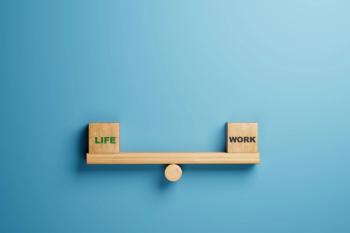
How Physicians Can Balance Time, Involvement, and Satisfaction
Breaking down work-life balance into three separate components could actually help doctors truly achieve it.
If you didn’t think you had enough to worry about with work-life balance, you can now add the following to your to-do list: In order to achieve work-life balance, it is important to find equilibrium between the three separate components of work-life balance. These include time balance (equal amounts of time spent at work and home), involvement balance (equal amounts of psychological balance at work and home), and satisfaction balance (equal levels of satisfaction in work and family). This is according to the European Agency for Safety and Health at Work (
Let’s look at these issues separately. Physicians typically spend a lot of time at work, even in a society where the norm is to spend a lot of time at work. However, I still hope that my home/family/personal role consumes the larger amount of time. Work is an important function for anyone. It is a large part of my identity and I feel a calling to be a physician, so it goes even deeper than a functional occupation.
That said, I can’t imagine spending equal amounts of time in my home role and my work role. Not only is work demanding in a way that being at home is not (even though there are a lot of demands, it is not constant and I can rest, relax, eat, sleep, etc.), but I don’t live to work. I live to live. While work is a large, important, and deeply meaningful part of my life, I can’t endorse the idea that it should account for 50 percent of my awake time, even though some weeks it surpasses that total.
Involvement balance may be an easier goal to achieve. While I consider myself above average on the level of home-involvement I achieve, I remain deeply involved in my professional role. It’s hard to put aside the role of physician even when you are at soccer practice with the kids or enjoying a backyard barbeque. I get asked questions. I weigh in on important social issues that affect population and community health. I think about my patients.
Finally is satisfaction balance. This is how I define satisfaction balance. There are some mornings I’m sad to leave my family behind. Maybe it’s a beautiful summer day and they are planning on a fun outdoor activity that I’d love to be a part of. Or maybe it’s a school field trip day and I’d like to be the chaperone. However, there are other mornings when I can’t wait to get to work. Some combination of kids are screaming. Someone forgot that the big project is due today. My husband is grumpy from a bad night’s sleep. And I am super excited that I get to leave the madness behind and escape to the relative calm of my office. Another way to look at it is that I enjoy being with my patients and the moments we share often. I also enjoy the satisfaction of picking up kids from school and going to dental visits, after-school activities, or just curling up on the couch to read together.
There’s some value in this approach to defining work-life balance more clearly, but I would argue that the components that contribute to work-life balance aren’t fixed. You don’t go down the three-item list and check each off in order to achieve balance. Rather, I think, you define your own components that equate with work-life balance.
Newsletter
Optimize your practice with the Physicians Practice newsletter, offering management pearls, leadership tips, and business strategies tailored for practice administrators and physicians of any specialty.




